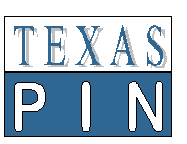

NEW DATA ON PESTICIDES IN TEXAS PUBLIC DRINKING WATER SOURCES
(September 2000)
Data is now available from a U.S. Geological Service (USGS) study of 48 drinking water reservoirs in Texas. Under a contract from the Texas Natural Resource Conservation Commission (TNRCC), USGS conducted one-time sampling of these reservoirs both pesticides and for volatile organic compounds such as benzene and MTBE, a gasoline additive. The pesticide testing results are summarized below. Full results of the study are available from TNRCC (Greg Rogers: GLROGERS@tnrcc.state.tx.us).
Atrazine, an herbicide widely used on corn and sorghum was found in 46 of 48 reservoirs tested. The highest level detected in the USGS testing was in Lake Granger (1.4 mg/liter). The federal drinking water standard for atrazine is 3 mg/liter. Other pesticides detected frequently included diazinon (12 reservoirs), metolachlor (27 reservoirs) and simazine (25 reservoirs). Table 1 summarizes results for the most frequently detected pesticides.
Other pesticides detected in the sampling included tebuthiuron, prometon, dieldrin, malathion, metribuzin, molinate, methyl parathion, 2,4-D, diuron, fenuron and fluometuron.
The lakes with the most pesticide detections were Lake Granger, Buffalo Springs Lake, Lake Meridith, Lake Texana and Lake Houston. Aquilla Lake, a small water supply lake in central Texas, generally had some of the highest levels of pesticides. No pesticides were detected in Lake Sweetwater or Lake Murvaul.
For those pesticides for which federal safe drinking water standards exist, no pesticides were detected in concentrations exceeding the standard. The test data, however, represent just a one-time sample “snapshot” of reservoir conditions and do not necessarily capture peak concentrations of pesticides.
In addition to the lakes identified above, the following drinking water reservoirs were sampled by the USGS: Anahuac, Belton, Bonham, Bridgeport, Brownwood, Cedar Creek, Choke Canyon, Donna, Falcon, O.C. Fisher, Fort Fantom Hill, Greenbelt, Hubbard Creek, O.H. Ivie, Kickapoo, La Feria, Limestone, McKenzie, Medina, Mexia, Proctor, Sam Rayburn, Richland-Chambers, Somerville, E.V. Spence, Stamford, Sweetwater, Tawakoni, Toledo Bend, J.B. Thomas, Travis, Tyler, Waco, White River, and Wright-Patman.
USGS is currently finishing a similar study for groundwater wells that serve public drinking water systems. Results should be available in 2001. A full description of the USGS study objectives and methods can be found in USGS Fact Sheet 010-00, January 2000, available from the USGS office in Austin, Texas (512) 927-3500.
The TNRCC contracted with USGS for the pesticide sampling after the
Texas Pesticide Information Network (TXPIN) and others raised concerns
that the state’s Source Water Assessment Program lacked sufficient information
on pesticides and water quality. The USGS data should help TNRCC
and water supply systems better understand what pesticides might be getting
into drinking water reservoirs and begin to examine how to prevent such
contamination.
TABLE 1. MOST FREQUENTLY DETECTED PESTICIDES IN USGS DRINKING
WATER RESERVOIR SAMPLING IN TEXAS (1999-2000)
| Pesticide | # of Reservoirs in which Pesticide was detected* | Highest concentrations
(mg/liter or ppb**) |
Reservoir | Federal Drinking Water Standard (mg/liter or ppb**) |
| Atrazine | 46 | 1.4 | Granger | 3.0 |
| 1.32 | Aquilla | |||
| Diazinon | 12 | 0.0692 | Granger | No standard |
| 0.0654 | White Rock | |||
| 0.0614 | Lavon | |||
| Metolachlor | 27 | 0.287 | Aquilla | No federal standard |
| 0.23 | Granger | |||
| 0.125 | Texana | |||
| Simazine | 25 | 0.524 | Ray Hubbard | 4.0 |
| 0.314 | Grapevine | |||
| 0.23 | Lewisville | |||
| 0.148 | Livingston | |||
| 0.107 | Texana |